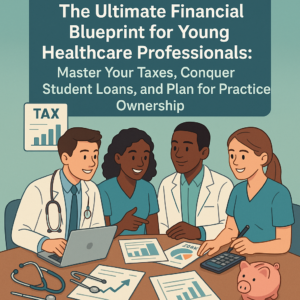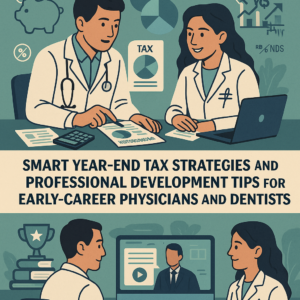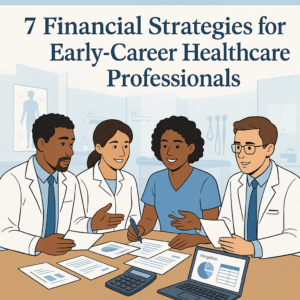The Ultimate Financial Blueprint for Young Healthcare Professionals
Starting your career as a dentist or physician is exciting—but it also brings unique financial challenges. From juggling student loan payments and 1099 taxes to planning for retirement and someday owning a practice, there’s a lot to tackle. This guide offers a clear, step-by-step plan to help young healthcare professionals master their finances, build lasting security, and pursue practice ownership with confidence.
Key topics: tax planning for doctors, dentist student loan management, retirement planning for healthcare professionals, fiduciary financial advisor for doctors.
1. Understanding Your Financial Starting Point
Every strong financial plan begins with an honest look at where you stand today. Take time to gather your numbers and commit to tracking them regularly.
1.1 Budgeting and Cash Flow
• List all income sources (W-2 salary, 1099 contractor work, side gigs).
• Track monthly expenses: rent or mortgage, utilities, groceries, insurance, student-loan payments, practice expenses (if any).
• Aim for a simple zero-based budget—every dollar is assigned a purpose.
1.2 Student Loan Snapshot
Outline each loan: remaining balance, interest rate, repayment plan (e.g., income-driven repayment, public student loan forgiveness), and monthly payment. A clear picture helps you compare strategies like refinancing versus staying on an income-driven plan.
1.3 Tax Profile
If you’re a 1099 contractor or part owner of a practice, you must handle quarterly tax filings. Even if you’re W-2, additional income streams can complicate your tax picture. Starting early gives you more time to optimize deductions, retirement contributions, and potential entity structures.
2. Mastering Tax Planning for Doctors
Effective tax planning can save thousands annually. Here’s how to get started:
2.1 Quarterly Estimated Taxes
If you receive 1099 income or have side revenue, calculate your estimated tax payments each quarter. Tools like IRS Form 1040-ES worksheets or online calculators can help. Underpaying leads to penalties; overpaying ties up cash you could invest.
2.2 Business Entity Considerations
Operating as an S-corporation or LLC may offer tax benefits. Earnings distributed as dividends can avoid self-employment tax. Work with a qualified CPA or an fiduciary financial advisor for doctors to weigh the costs and complexity.
2.3 Maximizing Deductions
- Retirement contributions (401(k), SEP IRA, SIMPLE IRA)—reduce taxable income.
- Business expenses—home office, CME courses, professional dues, malpractice insurance.
- Health savings account (HSA) contributions if you have a high-deductible health plan.
Keep thorough receipts and log business mileage automatically with an app.
3. Conquering Student Loan Management
Student debt can feel overwhelming. But with a tailored student loan management plan, you can reduce interest costs and gain peace of mind.
3.1 Income-Driven Repayment vs. Refinancing
Income-driven plans cap your payment based on your discretionary income—often 10%–15%. If you expect loan forgiveness (Public Service Loan Forgiveness or 20-year forgiveness), staying on that track makes sense. If you have solid cash flow, refinancing at a lower interest rate could save money but forfeits federal protections.
3.2 Forgiveness Programs
- Public Service Loan Forgiveness (PSLF)—available after 120 qualifying payments for government or nonprofit employers.
- State-specific programs—some states offer loan repayment assistance for practice in underserved areas.
- 20 years of payments on an Income Driven Repayment program may result in forgiveness of the remaining loan balance.
3.3 Prepayment Strategies
If you aim to pay off debt aggressively, apply extra payments to the principal on the highest-rate loans first. Automate an additional fixed amount monthly to reduce your balance faster.
4. Building a Solid Retirement Plan
Even early-career physicians and dentists should prioritize retirement planning. Time is your greatest ally when compounding growth is on your side.
4.1 Retirement Account Options
- 401(k) or 403(b) through your employer—max out any matching contributions first.
- Individual Retirement Accounts (Traditional IRA or Roth IRA)—consider Roth if you expect higher tax rates later.
- SEP IRA or Solo 401(k) if you have side income or run a small practice.
4.2 Asset Allocation Basics
Young professionals can afford a growth-oriented mix, then gradually shift toward more conservative allocations as you near practice ownership or retirement.
4.3 Catch-Up Contributions
Once you turn 50, you can make catch-up contributions in addition to the annual limit. Plan ahead so you’re ready to boost savings when the time comes.
5. Planning for Practice Ownership
Owning your own dental or medical practice can be rewarding—but it requires careful financial and operational planning.
5.1 When to Consider Ownership
• You have stable cash flow and a solid credit history.
• You understand local market demand and have a clear business plan.
• You’re prepared for upfront costs: real estate, equipment, staffing.
5.2 Financing Your Practice
- Bank loans or SBA loans—competitive rates but strict underwriting.
- Seller financing—may require higher interest but fewer upfront costs.
- Partner buy-ins—pool resources with colleagues to lower individual debt.
5.3 Practice Management Consulting
Expert guidance can streamline billing, staffing, and compliance. Explore our Our Process page to see how we help healthcare clients launch and grow practices.
6. Risk Management and Insurance
Protecting your income and loved ones is a vital part of your financial blueprint.
6.1 Term Life Insurance
Term policies offer high coverage at low cost. As your income grows, you can layer on additional policies to match evolving needs.
6.2 Disability Insurance
A top-priority for physicians and dentists—covering 50%–60% of your gross income if illness or injury prevents you from working.
6.3 Malpractice and Liability
Ensure you have adequate malpractice coverage, especially if you’re transitioning to private practice ownership. Umbrella liability policies can provide an extra layer of protection.
7. Why Choose a Fiduciary Advisor?
Working with a fiduciary financial advisor ensures your interests come first. Here’s what to expect when you partner with us:
- Transparent Fees: $1,200 onboarding + $2,400/year. Asset management is free under $200K, 0.3% over $200K.
- Comprehensive Services: Quarterly check-ins, on-call support, detailed analyses of taxes, student loans, investments, and insurance.
- Structured Process: Four onboarding meetings covering organization, goals, risk management, and customized recommendations.
- Ethical Standards: As a CFP®, MBA, and IRS Enrolled Agent, we follow strict standards of conduct and avoid conflicts of interest.
Disclaimer: This information is educational only and does not constitute personalized advice. Past performance does not guarantee future results.
8. Creating Your Personalized Financial Blueprint
Pulling it all together, your financial blueprint should include:
- A clear budget and cash-flow plan updated monthly.
- Quarterly tax payment schedule with entity-structure reviews.
- Student loan strategy aligned with your career path.
- Retirement account setup and target asset allocation.
- Insurance coverage to protect income and family.
- Timeline and criteria for practice-ownership decisions.
9. Next Steps
You don’t have to navigate your financial journey alone. Schedule a free discovery call today to explore how we can help you build and execute your personalized financial plan.
Questions? Contact us directly at marcus.miller@mainstay-capital.com or call 813-699-9317.






